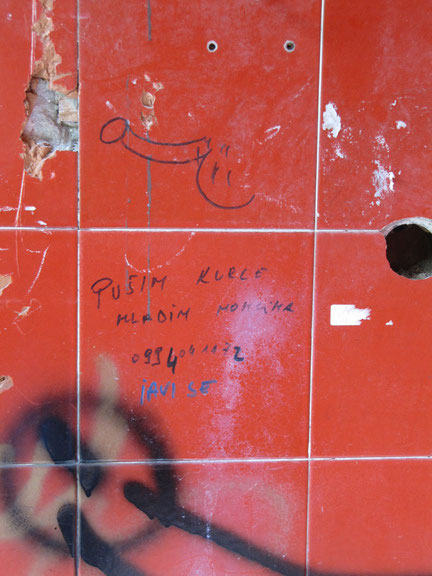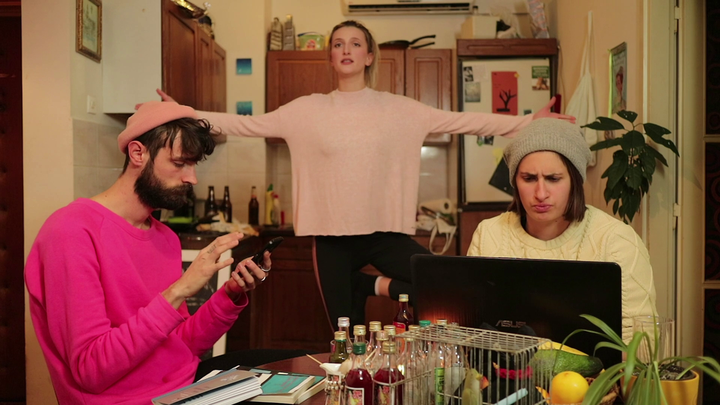Thirteen years ago, the collective queerANarchive was founded in Split, the second largest city in Croatia. The years of its formation were largely characterized by civil resistance to the privatization of public spaces and the struggle to keep them accessible. At the time, different organizations of civil society all over the country organized big protests to protect city squares and nature parks, as well as to provide public spaces for independent culture, in Zagreb, Dubrovnik, Pula, Rijeka, Karlovac, Split, and other cities. It was in this atmosphere that the idea of a collective dedicated to queer[counter]publics and the spaces they inhabit was born.
The need to initiate the collective and engage with queer culture and art was also propelled by my personal urge. At that time, there was no queer community in Split, no queer spaces, programs, or activities. They all needed to be invented. So together with others, I made that my job. Alongside Split Pride and Queer Sport Split, we gave a start to the vibrant queer scene that we have today.
Later, in 2015, queerANarchive joined a local platform – Platforma Doma mladih [the Platform of the Youth Center] – a group of independent art collectives and organizations that advocate for the shared use of the space and facilitate artistic, educational and community programs at Dom mladih [the Youth Center]. The building of Dom mladih itself is a relic from socialist times – a multifunctional cultural complex called “House of Socialist Youth” whose construction started in 1979 but was never completed. Still unfinished, Dom mladih has provided a space for the organic development of independent culture and art scene since 1994.1 The Platform, like many other civil organizations in the country, aspires to a hybrid model of public-civil partnership and participatory governance.2
In 2018 queerANarchive initiated another platform based on the experience of Platforma Doma mladih. The city’s LGBTIQ organizations together started the development of a socio-cultural LGBT center for the local community. Providing a safe space for participation in culture and sociality proved to be crucial in building and empowering queer people in Split. Several art initiatives sprouted from this collectivity. For instance, Nikolina Banić, a queer activist and co-organizer of Split Pride, gathered a team of amateur filmmakers, and in collaboration with Cine Club Split3 and queerANarchive produced two seasons of the lesbian-gay web series Maništra pomidore (Pasta with Tomatoes) (2017–2019).4 Shot in Croatian and widely popularized across the country, the show was about the lives of two lesbians and a gay who shared an apartment together in Split. Following their everyday adventures, the series humorously commented on the challenges that LGBTIQ people in Split faced daily. This led to another project – PrideTV (2020–2022).5 Borrowing the format of traditional TV news reporting filmed in front of a green screen (for that, a wall in the LGBT center Split was painted green), PrideTV provided witty queer commentary and sharp critique on current socio-political events from the perspective of LGBTIQ persons. As Nikolina remarked in our conversation, both PrideTV and Maništra pomidore were “created out of pure enthusiasm and love for the LGBTIQ community and friends.”
From its inception, the queerANarchive collective aimed its artistic research on documenting queerness and tracing the sexual practices of non-heterosexual citizens of Split. The idea for our first artistic research project came from blog entries and occasional DIY zines on the everyday of local cruising. In 2014, the project Interspaces [of faggotry] brought together artists and researchers such as Diana Magdić, a sociologist and activist for public spaces, Vladimir Tatomir, an independent curator and museologist, Antun Sevšek, a cartographer, and myself, an art historian and curator. Our impulse of inquiry came from observing a big shift in the Croatian queer community that was propelled, on the one hand, by mainstream LGBT activism that had been (and still is) normalizing the community in terms of heteronormative society, and on the other hand, by the transfer of gay men’s dating practices to the online world. The research was inspired by Michel de Certeau who asserted that “history begins at ground level, with steps.”6 Tracing the steps of cruising practitioners, collecting artifacts from cruising grounds and video documenting spaces we wanted to evaluate this hardly visible practice of men looking for sex but also socializing with other men. A closer look unveiled alternative modes of social, intimate and care relations between the practitioners. Collected materials led to exhibitions in Split and Zagreb, and to a publication. In the end, this first project defined the collective’s agenda of programming for the following years where special attention to the particularities of queer culture in its widest definitions, queer histories, memories and archives would always be at the core.
In 2016–2017 the queerANarchive conducted another research, (In)visible traces of a history. The team of curators, journalists and artists – Barbara Matejčić, Ivana Čuljak, Marko Gutić Mižimakov, Ivan Jamić, Tanja Minarik, Petra Mrša and myself – stepped back in time into the area of memory: the memory of those men who in the not-so-distant past achieved their self-realization in intimate and romantic company with other men. The need to record these memories arose from a vague sense of loss – the loss that was recognized as a failure of cultural memory to integrate the memory of the non-conforming other. We collected oral histories from generations of men before us: how they met and built their communities. Lacking visual materials to illustrate their stories, we adopted a methodology based on archival practices such as repetition, reproduction, and reinterpretation.7 We gathered groups of young artists and activists, read and discussed the collected oral histories, and then, equipped with photo and video cameras, went to different cruising locations, authentic and new ones, in order to recreate the selected situations and document them. These visual materials of reenactments became new evidences of our queer history which could be lost overwise. The research’s outcome was presented as an exhibition in Zagreb and Split, in 2017, accompanied by a publication.
Nowadays, the collective runs several programs, ranging from solo exhibitions of queer artists, a festival, to creative workshops for the local community, like for example porno-taro-cards making, silkscreen printing, analog photography, and digital video production. Around the exhibition program, residencies and production activities developed over time, and once the collective got its community, a clubbing program was established, focused on the promotion of safe and inclusive space as well as queer DJing, as for instance at Klub Kocka.8
Together with the queerANarchive collective, Split’s queer community has been growing. While I wrote this text, the seventh edition of qFEST took place in the city. One could notice a large group of people, the festival’s participants and audience members, who were present at all events. Igor Mušić, a colleague from queerANarchive’s office, commented that now he finally knew who the actual reference of “the queer community of Split” really was.
Marko Gutić Mižimakov, a visual artist and collective’s long-term collaborator, adds this comment about queerANarchive: “In the middle of the roughest city in Croatia, queer art, discourse, and expression are constantly present through their program in the community. One day it’s a local drag artist, the next weekend there’s an established artist from Vienna in the same space, then an activist workshop from Brazil takes place - and everyone gets the same production treatment, space, promotion and more.”9
Endnote:
In a spirit of queer transnational collectivity, mutual artistic engagements, and creative conviviality, here’s a list of all the artists who in some way have contributed to what queerANarchive is today: Darko Aleksovski, Bram Belloni, Elfrida Bergman, Željko Blaće, Dyveke Bredsdorff, Denis Butorac, Kiernan Cobarrubia, Hrvoje Cokarić, Ivana Čuljak, Caitlin Davis Fisher, Andrea Giuliano, Carmen Grimm, Marko Gutić Mižimakov, Masha Godovannaya, Vigur Gurdu, House of Dynasty, Ana Hoffner ex-Prvulovic*, Lana Hosni, Callum Leo Hughes, Tara Ivanišević, Helena Janečić, Ana Jelušić, Ena Jurov, Hana Jušić, Josip Knežević, Maria Kniaginin-Ciszewska, Tihana Mandušić, Ivana Kragić Marinić. Antonio Kiselić Ledinski, Marin Lemić, Rafael Medina, Irene Melix, Pol Merchan, Martyna Miller, Ana Opalić, Ines Kotarac, Sanja Kovačević, Sholem Krishtalka, Hrvoje Kruljac, Vianney Le Caer, Sara Lindquist, Ronald Panza, Martin Petrus, Aleksandar Macko Puhek, Diana Magdić, Guilherme Maggessi, Barbara Matejčić, Maja Marković, Maria Mitsopoulou aka Maria F Dolores, Rafal Morusiewicz, Petra Mrša, Jörg Meier, Tanja Minarik, Peter Mollet, Karen Nhea Nielsen, Zvonimir Novak, Gabi Nunez, Bradley Secker, Anni Simati, Lara Tabet, Vladimir Tatomir, Nika Pećarina, Luka Pešun, Sonja Pregrad, Karol Radziszewski, Cigdem Yuksel, Influencerica Ulla, Darko Škrobonja, Katarina Šoškić, Petar Vranjković, Liliana Zeic, Paweł Żukowski and all future others who will join us in our path.
1 For more information about the history of Dom mladih and its organization, see D. Peračić, M. Veljačić, S. Tolj., E. Višnić, We need it – we do it: Croatia at the 15th International Architecture Exhibition / La Biennale di Venezia 2016 Reporting from the Front [Exhibition Catalogue]. Platforma 9.81, 2016.
2 For more information, see: https://dom-mladih.org/en/youth-center-split/ and https://pdm.hr/platforma-doma-mladih/
3 More information on Cine Club Split: https://kinoklubsplit.hr/info-eng/
4 https://vimeo.com/channels/1299986
5 https://www.youtube.com/playlist?list=PL6wU81qz9Mtq6PiEk48eTh_FOBcObRiwm
6 Michel de Certeau, The Practice of Everyday Life, California 2011.
7 This methodology is a reflection on Jacques Derrida’s concept in Archive Fever where he links Freud’s concept of the death drive with the archive: “[T]he archive is created at the place of the original and structural breakdown of memory”. (Jacques Derrida, Archive Fever: A Freudian Impression, in: Charles Merewether (ed.), The Archive, London, Cambridge 2006, p. 78.)
8 A short experimental video Dragon Hunt by Marko Gutić Mižimakov, one of the contributors to this issue, was produced within this framework.
9 Marko Gutić Mižimakov in an interview for Vizkultura: https://vizkultura.hr/intervju-marko-gutic-mizimakov/




![queerANarchive, artistic research <i>Interspaces [of faggotry]</i>, photography, 2014](/media/ausgaben/queerANarchive__Interspaces_of_faggotry_photography_2014_1.medium.JPG)